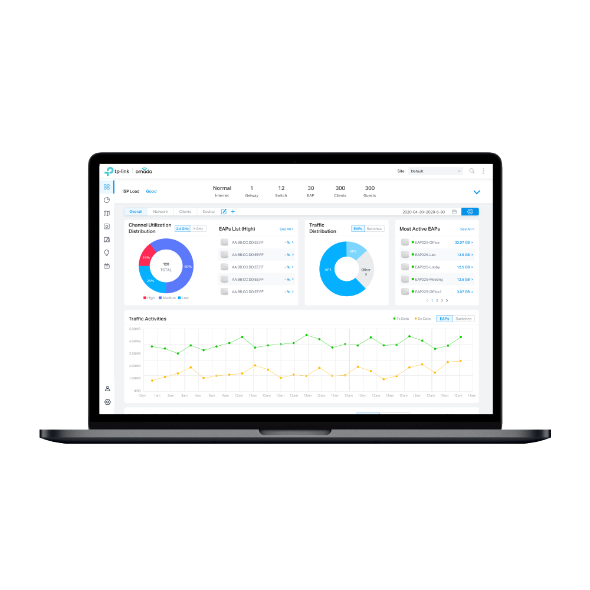How to upgrade MongoDB from v4.4 to v7 on Linux System
Contents
Upgrade MongoDB from v4.4 to v5
Here we introduce the commands our customers can use to upgrade MongoDB to the latest version on Linux system.
- Ubuntu 20.04, Ubuntu 22.04
- Omada Software Controller
- MongoDB
On Linux system, the dependency MongoDB requires to be installed by the customer manually. MongoDB has strict requirements for inter-version data compatibility. If you need to upgrade your MongoDB in your Linux system, you should upgrade it version by version. In this article, we take Ubuntu 20.04 as an example to introduce the commands for upgrading MongoDB from v4.4 to v5, from v5 to v6, from v6 to v7. You can use the corresponding commands according to your need.
Upgrade MongoDB from v4.4 to v5
Step 1. Backup database and uninstall Controller.
You can use the following commands to uninstall Controller:
sudo dpkg -r omadac
A window will pop up. Choose Yes.

Choose Yes

Note: the backup db file will be restored in /opt/tplink/omada_db_backup
![]()
Backup the db.tar.gz file to another folder to restore once a failure happens, here we copy it to the folder /Document/dbbackupv4

Step 2. Uninstall MongoDB v4.4
Use the following commands to uninstall MongoDB v4.4:
sudo apt remove mongodb-*
Type y

Use the following command to delete file mongodb-org-4.4.list
sudo rm /etc/apt/sources.list.d/mongodb-org-4.4.list
Step 3. Install MongoDB v5
Use the following commands to install MongoDB v5:
curl -fsSL https://www.mongodb.org/static/pgp/server-5.0.asc | \
sudo gpg -o /usr/share/keyrings/mongodb-server-5.0.gpg \
--dearmor

echo "deb [ arch=amd64,arm64 signed-by=/usr/share/keyrings/mongodb-server-5.0.gpg ] https://repo.mongodb.org/apt/ubuntu focal/mongodb-org/5.0 multiverse" | sudo tee /etc/apt/sources.list.d/mongodb-org-5.0.list

sudo apt-get update

sudo apt-get install -y mongodb-org

Step 4. Reinstall Omada Software Controller
Go to where Omada Software Controller deb file stores, here we take omada_v5.14.26.1_linux_x64_20240621095737.deb as an example.
sudo dpkg -i omada_v5.14.26.1_linux_x64_20240621095737.deb

Choose yes, the controller will import the backup db file in /opt/tplink/omada_db_backup.

After installation, the Controller will start automatically.
Step 5. Change the FeatureCompatibilityVersion
When Controller starts up successfully. Use the following commands to startup Mongo Shell:
mongosh -port 27217

db.adminCommand( { setFeatureCompatibilityVersion: "5.0" } )
![]()
Step 1. Backup database and uninstall Controller.
Use the following commands to uninstall Controller:
sudo dpkg -r omadac
A window will pop up. Choose Yes

Choose Yes

Note: the backup db file will be restored in /opt/tplink/omada_db_backup
![]()
Backup the db.tar.gz file to another folder to restore once a failure happens, here we copy it to the folder /Document/dbbackupv5

Step 2. Uninstall MongoDB v5
Use the following commands to uninstall MongoDB v5:
sudo apt remove mongodb-*
Type y

sudo rm /etc/apt/sources.list.d/mongodb-org-5.0.list
Step3. Install MongoDB v6
Use the following commands to install MongoDB v6:
curl -fsSL https://www.mongodb.org/static/pgp/server-6.0.asc | \
sudo gpg -o /usr/share/keyrings/mongodb-server-6.0.gpg \
--dearmor

echo "deb [ arch=amd64,arm64 signed-by=/usr/share/keyrings/mongodb-server-6.0.gpg ] https://repo.mongodb.org/apt/ubuntu focal/mongodb-org/6.0 multiverse" | sudo tee /etc/apt/sources.list.d/mongodb-org-6.0.list

sudo apt-get update

sudo apt-get install -y mongodb-org

Step 4. Reinstall Omada Software Controller
Go to where Omada Software Controller deb file stores, here we take omada_v5.14.26.1_linux_x64_20240621095737.deb as an example.
sudo dpkg -i omada_v5.14.26.1_linux_x64_20240621095737.deb

Choose yes, the controller will import the backup db file in /opt/tplink/omada_db_backup.

After installation, the Controller will start automatically.
Step 5. Change the FeatureCompatibilityVersion
When Controller starts up successfully. Use the following commands to start up Mongo Shell:
mongosh -port 27217

db.adminCommand( { setFeatureCompatibilityVersion: "6.0" } )
![]()
Step 1. Backup database and uninstall Controller
Use the following commands to uninstall Controller:
sudo dpkg -r omadac
A window will pop up. Choose yes

Choose yes

Note: the backup db file will be restored in /opt/tplink/omada_db_backup
![]()
Backup the db.tar.gz file to another folder to restore once a failure happens, here we copy it to the folder /Document/dbbackupv6

Step 2. Uninstall MongoDB v6
Use the following commands to uninstall MongoDB v6:
sudo apt remove mongodb-*
Type y

sudo rm /etc/apt/sources.list.d/mongodb-org-6.0.list
![]()
Step 3. Install MongoDB v7
Use the following commands to install MongoDB v7:
curl -fsSL https://www.mongodb.org/static/pgp/server-7.0.asc | \
sudo gpg -o /usr/share/keyrings/mongodb-server-7.0.gpg \
--dearmor

echo "deb [ arch=amd64,arm64 signed-by=/usr/share/keyrings/mongodb-server-7.0.gpg ] https://repo.mongodb.org/apt/ubuntu focal/mongodb-org/7.0 multiverse" | sudo tee /etc/apt/sources.list.d/mongodb-org-7.0.list

sudo apt-get update

sudo apt-get install -y mongodb-org

Step 4. Reinstall Omada Software Controller
Go to where Omada Software Controller deb file stores, here we take omada_v5.14.26.1_linux_x64_20240621095737.deb as an example.
sudo dpkg -i omada_v5.14.26.1_linux_x64_20240621095737.deb

Choose yes, the controller will import the backup db file in /opt/tplink/omada_db_backup.

After installation, the Controller will start automatically.
Step 5. Change the FeatureCompatibilityVersion
When Controller starts up successfully. Use the following commands to start up Mongo Shell:
mongosh -port 27217

db.adminCommand( { setFeatureCompatibilityVersion: "7.0", confirm: true } ) 
After Changing FeatureCompatibilityVersion, you can use the following command to check the result:
db.adminCommand( { getParameter: 1, featureCompatibilityVersion: 1 } )
- If you have changed FeatureCompatibilityVersion to 5.0, the result should be:
![]()
- If you have changed FeatureCompatibilityVersion to 6.0, the result should be:
![]()
- If you have changed FeatureCompatibilityVersion to 7.0, the result should be:
![]()
Now you have successfully upgrade your MongoDB from v4.4 to v7 on Linux System.
Get to know more details of each function and configuration please go to Download Center to download the manual of your product.
Bu SSS faydalı mı?
Your feedback helps improve this site.








